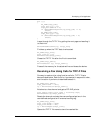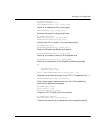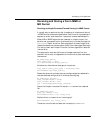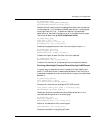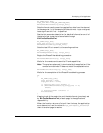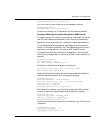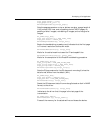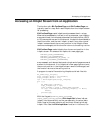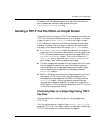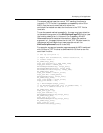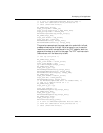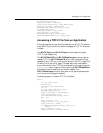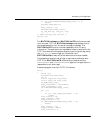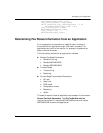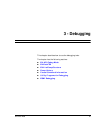
Developing a Fax Application
November 2009 84
Processing, Bfv API Reference Manual for detailed information on
how to access user-defined infopkts when using the
INDIR_MODE_FOLLOW_NOUSER flag.
Sending a TIFF-F Fax File Within an Infopkt Stream
Transmitting a fax stored as a TIFF-F file is accomplished using the
TIFF-F fax routines, as described earlier in this chapter, or using an
infopkt of type INFOPKT_INDIR_TIFF within an infopkt stream.
TIFF files contain resolution and width parameters for each page.
However, the same rules that apply to ordinary fax data streams
also apply to fax data streams that contain INDIR_TIFF infopkts:
A DOCUMENT_PARAMETERS infopkt must be the first infopkt in
the stream, but the resolution specified by (the first page) of the
TIFF file takes precedence over the resolution specified by the
DOCUMENT_PARAMETERS infopkt. This rule is in effect only if
INDIR_TIFF occurs right after the DOCUMENT_PARAMETERS or
other infopkt types indicating beginning-of-page.
To insert a page break between the last page of the first file and
the first page of the second file, one of the infopkt types that
indicate a beginning-of-page (see
Accessing an Infopkt Stream
from an Application on page 83) must be present between
INDIR_TIFF infopkts.
ASCII or G3 data are combined on a single page with the first or
last page of a TIFF file by constructing the stream with no
new-page type infopkt between the ASCII or G3
data and the
INDIR_TIFF infopkt. G3
strip parameter packets might be
required (see
Infopkts on page 42); the resolution and width of
the G3 data in a TIFF file is always specified in the TIFF file, not
in the G3
strip parameter packet.
Combining Data on a Single Page Using TIFF-F
Fax Files
Two methods exist for combining data on a single page using
TIFF-F files.
The first method uses an infopkt of type INFOPKT_INDIR_TIFF to
embed a TIFF-F file in an infopkt stream, as described in Sending a
TIFF-F Fax File Within an Infopkt Stream on page 84.



